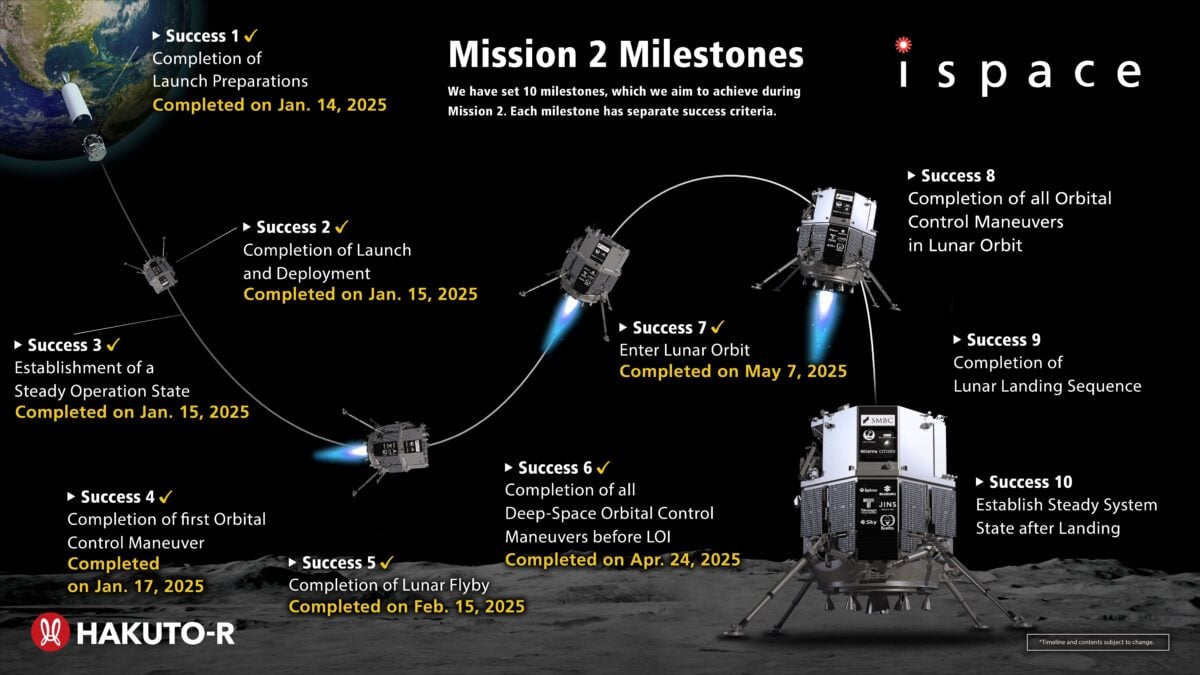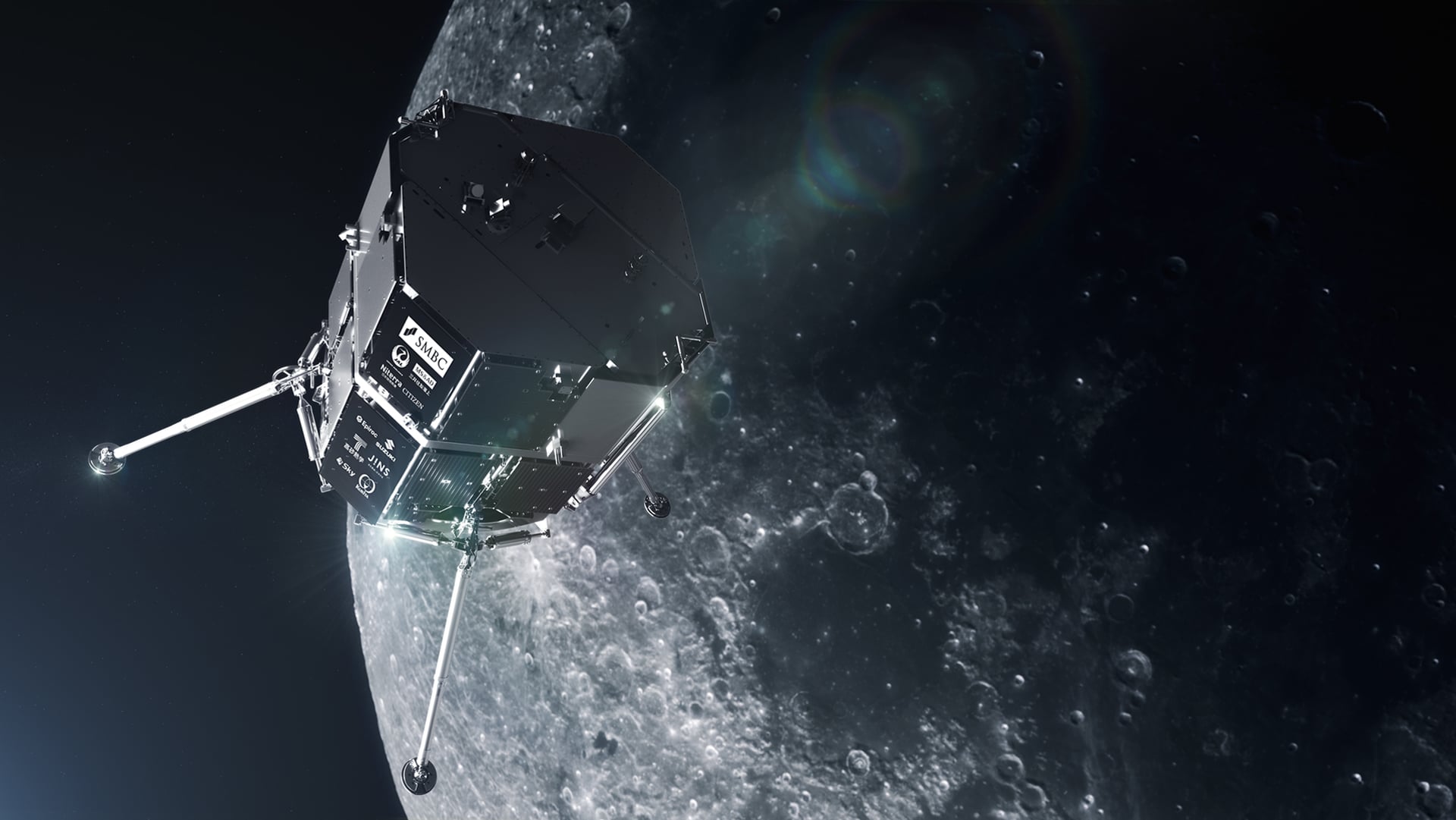Headquartered in Japan, the commercial space company ispace is dedicated to creating robotic spacecraft and other technology to support the discovery, mapping, and harvesting of natural resources on the Moon. One of the main tools in their arsenal is the RESILIENCE lander, a small, lightweight uncrewed spacecraft designed for low-cost, high-frequency transportation of instruments and other supplies to the lunar surface. Earlier today, the company announced that their second mission with the RESILIENCE lander (SMBC x HAKUTO-R Venture Moon) entered lunar orbit.
According to a company statement, the orbital injection maneuver was completed by 5:41 a.m. JST (1:41 p.m. PST; 4:41 p.m. EST) on May 7th, 2025. This marks the successful completion of the mission's seventh Mission Milestone, which included completing the first lunar orbit insertion maneuver and reaffirming "the ability of space to deliver spacecraft and payloads into stable lunar orbits." The orbital maneuver consisted of the longest thruster burn during Mission 2, lasting approximately 9 minutes. The team at the Mission Control Center in Nihonbashi, Tokyo, confirmed that RESILIENCE is now maintaining a stable attitude above the lunar surface.
On April 24th, 2025, RESILIENCE completed the maneuvers to transition the lander from deep space and closer to the Moon to complete the orbital injection. Before that, RESILIENCE completed a lunar flyby that verified the spacecraft's propulsion, guidance, control, and navigation systems. Following the flyby, the lander spent about two months in a low-energy transfer orbit. Mission specialists are now preparing for the final orbit maneuvers in preparation for a lunar landing, which is scheduled to take place no earlier than June 5th, 2025.
 RESILIENCE was launched on January 15th, 2025, at 12:44 p.m. PST (03:44 p.m. EST) atop a SpaceX Falcon 9 rocket. This constituted the successful completion of the first two Milestones, followed by the mission team establishing communications and confirming that its solar panels were drawing power (Milestone 3) and completing the first orbital maneuver that placed it on a course towards the Moon (Milestone 4). For this mission, the RESILIENCE is transporting several payloads for commercial customers.
RESILIENCE was launched on January 15th, 2025, at 12:44 p.m. PST (03:44 p.m. EST) atop a SpaceX Falcon 9 rocket. This constituted the successful completion of the first two Milestones, followed by the mission team establishing communications and confirming that its solar panels were drawing power (Milestone 3) and completing the first orbital maneuver that placed it on a course towards the Moon (Milestone 4). For this mission, the RESILIENCE is transporting several payloads for commercial customers.
These include the TENACIOUS micro rover by ispace-EUROPE, which will be deployed on the surface to explore the landing site, collect lunar regolith, and relay data back to the lander. Other payloads include a water electrolyzer, a food production experiment, a deep space radiation probe, a commemorative alloy plate, and a "Moonhouse," a model house created by Swedish artists to be placed on the surface. The mission also carries a UNESCO memory disk, a cultural artifact containing data on humanity's linguistic and cultural diversity.
As UNESCO describes it, the disk "serves as a repository of cultural heritage," which will be preserved for millions of years in case human civilization collapses someday:
"Language serves as the connective tissue of humanity, facilitating interaction, collaboration and shaping our perceptions of the world. Its preservation in all its diversity is essential to safeguarding human identity... This initiative comes as we enter the second year of the International Decade of Indigenous Languages 2022-2032 and the release of the World Atlas of Languages in its Beta version where Focal Points from 127 countries actively contribute language data. By incorporating a variety of languages, including indigenous languages, the Memory Disc embodies an invitation to celebrate humanity's cultural richness and embrace a future that cherishes linguistic diversity."
The TENACIOUS rover is also a technological demonstration for mobility on the lunar surface and regolith extraction. The lessons learned will help pave the way for Mission 3, which is expected to launch in 2026 and will be the debut of the APEX 1.0 lunar lander. The fourth mission, which is scheduled for launch in 2027, will utilize the Series 3 lander currently being designed. These missions are part of the company's long-term goal of helping space agencies and commercial space companies create fuel stations and habitats on the Moon that could lead to a permanent human presence (see video above).
Per the company's statement, ispace Founder and CEO Takeshi Hakamada expressed great pride in this latest accomplishment:
First and foremost, we are extremely pleased that the RESILIENCE lander successfully reached lunar orbit as planned today. We have successfully completed maneuvers so far by leveraging the operational experience gained in Mission 1, and I am very proud of the crew for successfully completing the most critical maneuver and entering lunar orbit. We will continue to proceed with careful operations and thorough preparations to ensure the success of the lunar landing.
Further Reading:ispace.com
 Universe Today
Universe Today
